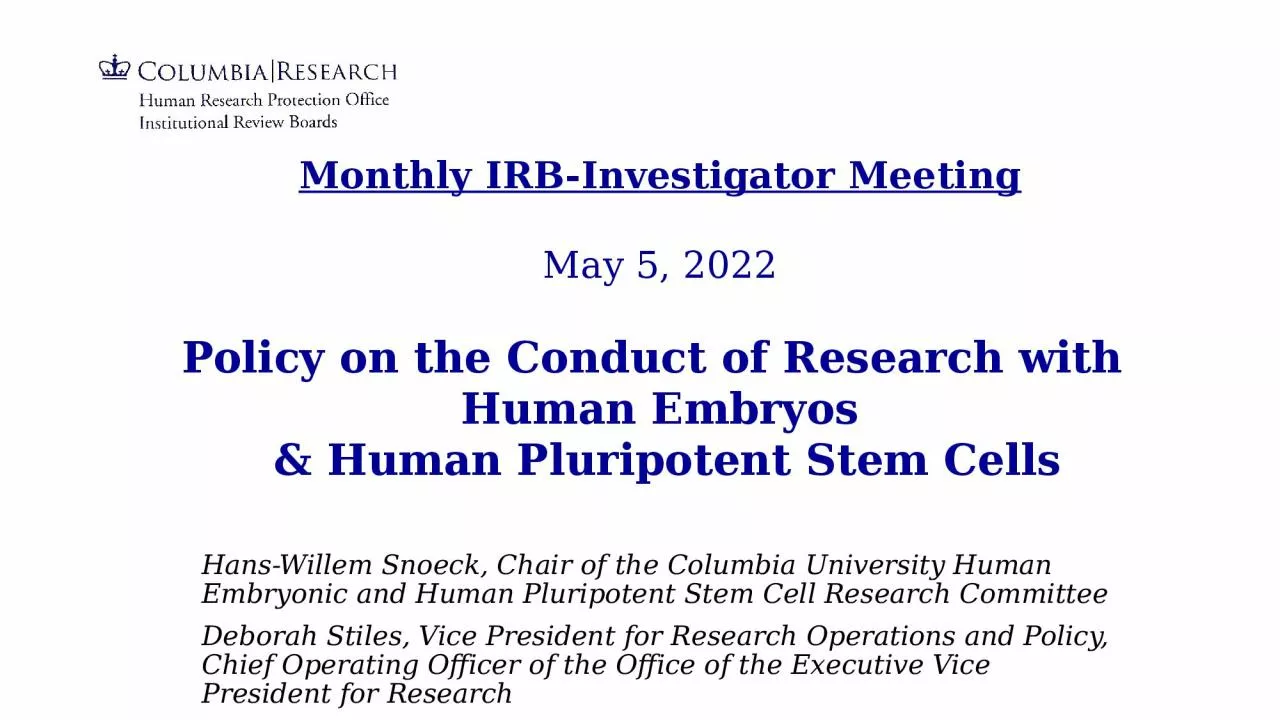

Deborah Stiles Vice President for Research Operations and Policy Chief Operating Officer of the Office of the Executive Vice President for Research Monthly IRBInvestigator Meeting May 5 2022 Policy on the Conduct of Research with ID: 1009374
Download Presentation The PPT/PDF document "Hans-Willem Snoeck , Chair of the Colu..." is the property of its rightful owner. Permission is granted to download and print the materials on this web site for personal, non-commercial use only, and to display it on your personal computer provided you do not modify the materials and that you retain all copyright notices contained in the materials. By downloading content from our website, you accept the terms of this agreement.
1. Hans-Willem Snoeck, Chair of the Columbia University Human Embryonic and Human Pluripotent Stem Cell Research CommitteeDeborah Stiles, Vice President for Research Operations and Policy, Chief Operating Officer of the Office of the Executive Vice President for ResearchMonthly IRB-Investigator MeetingMay 5, 2022Policy on the Conduct of Research with Human Embryos & Human Pluripotent Stem Cells
2. Stem cells: cell that can generate other cells in an organism or tissuePluripotent stem cells:Can make every cell of the body.Tissue-specific stem cellsCan make every cell of a given tissueImportant for regeneration after injury, growth(blood, intestine, skin, muscle, lung, bone…)Totipotent stem cells:Can make every cell of the body AND of extraembryonic tissues such as placentaESCRO
3. ES cell: embryonic stem cellsiPSC cell: induced pluripotent stem cell'adult stem cells’: bone marrow, lung, intestine….ESCRO = embryonic stem cell oversight, should be called ‘pluripotent stem cell’ oversight
4.
5. Organoids3D structure grown from stem cells and consisting of organ-specific cell types through cell sorting and spatially restricted lineage commitment and that shows some evidence of organ functionPluripotent stem cellsAdult stem cells
6. Why might we be concerned:Pluripotent/totipotent stem cells could theoretically be used to grow a human embryo in vitro. Therefore, if anyone wants to do research in that area, we need to know. This is currently not possible.Cells or organoids with neural (brain) potential could be generated. This is no problem, unless an investigator wants to implant those in an animal brain. Chance of animal with human cognition is very low, but we need to know and follow up.Organoids: brain organoids in vitro are not a problem. But what if we could achieve some form of cognition? Science fiction right now, but we need to know.Human embryos: can be grown to some extent in vitro. How far can this go? Currently 14 days or until certain developmental milestones are reached, whichever comes first.Human/animal chimeras to term: not allowed.
7. ChimerasPreliminary studies allowed, carrying to term notAllowed with monitoring in place
8. ChimerasWhy might we be concerned:If the human cells contribute to the pig brain: Is this still a pig? Does it need special protections? Or should it be destroyed right away because it breaches species boundaries? What is the ‘yuk’ factor here?Or if the pig develops more human facial features?Or if the human cells contribute to the germline, i.e. to oocytes or sperm cells?Blastocyst complementation is allowed, but cannot be carried to term, and monitoring plans need to be in place to rule out contribution to neural tissues and germline (and in my opinion to facial tissues).Even if data are provided that might justify carrying to term, breeding such animals is not allowed (because of risk of inadvertent germline transmission)
9. Jan and Hugo Van EyckGent, Belgium’Adoration of the Mystic Lamb’(developed oil painting)
10.
11. References:Link to the International Society for Stem Cell Research: https://www.isscr.org/policy/guidelines-for-stem-cell-research-and-clinical-translationLink to Columbia Stem Cell Research: https://research.columbia.edu/stem-cell-research